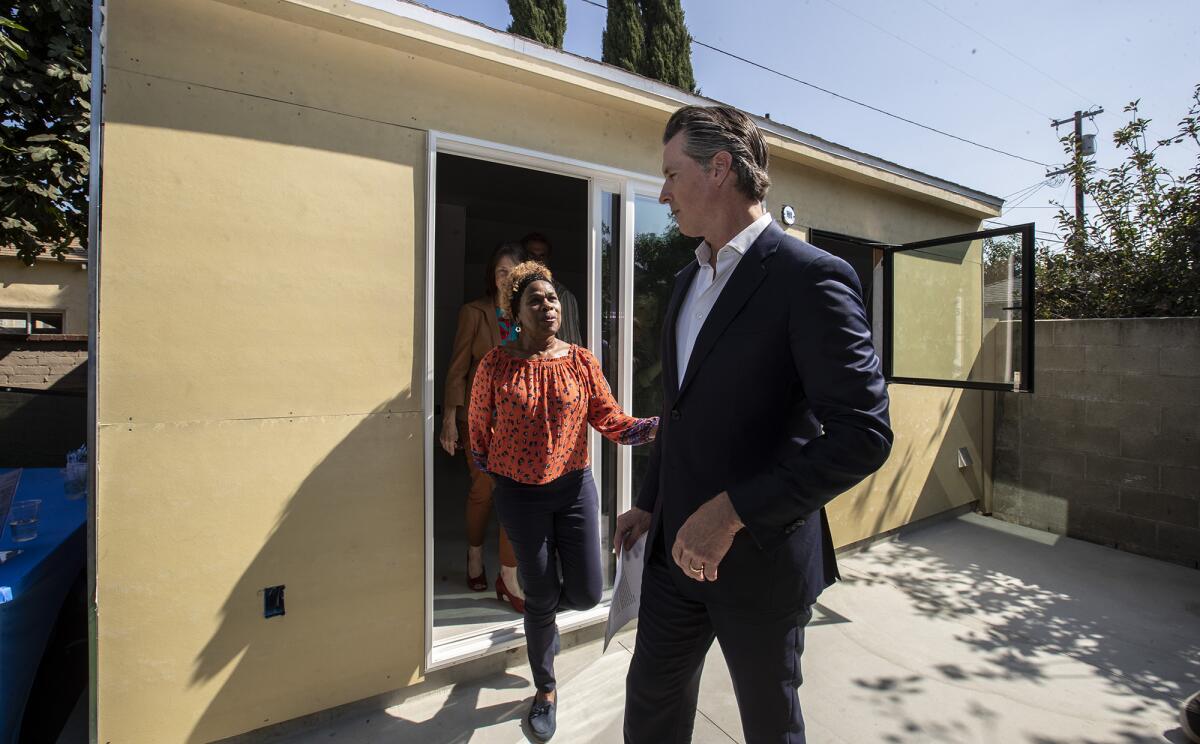How lawmakers are upending the California lifestyle to fight a housing shortage

- Share via
When California lawmakers tried earlier this year to force local governments to allow four or more homes on land zoned for single-family residences, fierce pushback from suburban communities stopped the plan in its tracks. For many, the long-standing neighborhood template of a home, backyard and garage on a lot was too intrinsic to the California lifestyle to upend.
But over the past four years, a suite of smaller proposals has quietly chipped away at zoning only for single-family homes, attracting comparably little blowback.
Lawmakers have made it easier for homeowners to convert garages into residential space and build small freestanding homes, sometimes known as granny flats or casitas, in their backyards. And on Wednesday, Gov. Gavin Newsom signed multiple bills into law that aim to spur construction, including legislation that will allow property owners to build a backyard home of at least 800-square-feet as well as convert a garage, office or spare room into a third living space.
The result is a patchwork of legislation that achieves much of what those pushing for more growth in the state have long wanted, allowing as many as three homes on parcels in most single-family neighborhoods across California.
“We’re on the precipice of single-family zoning functionally not existing,” said Ben Metcalf, former director of the state’s Department of Housing and Community Development.
Nearly two-thirds of the residences in California are single-family homes, according to U.S. Census data. And between half and three-quarters of the developable land in much of the state is zoned only for single-family housing, according to a recent survey by UC Berkeley’s Terner Center for Housing Innovation.
Owners of single-family lots aren’t able to build multiple-unit apartment complexes on their properties. But the new laws allow homeowners to build an additional unit detached from a single-family home and turn part of an existing structure into a third living space. State policies have eased the way for property owners to build such housing by stripping away local government and homeowners’ association requirements that previously blocked or slowed construction, and by curtailing other rules that forced homeowners to pay fees, install parking spots or live on the property prior to building the units.
Once the most recent laws take effect Jan. 1, cities and counties will generally only be able to prohibit the construction of accessory dwellings for health and safety reasons, including on properties at high risk of wildfires.
Supporters of the new rules say they will lead to substantial new building in single-family neighborhoods, something necessary to combat a shortage of available homes that has fueled the state’s housing crisis. And they contend smaller homes can help address the problem without changing the character of the community in a way some believe new apartment buildings might.
“During the Depression when we had a massive housing crisis, people converted their rooms in their houses and put in hot plates so others could live there,” said Denise Pinkston, an executive at Bay Area development firm TMG Partners and one of the driving forces behind the new laws. “They adapted their housing stock to serve the needs of the population. During this housing crisis we need to do the same thing.”
State legislators began wiping away restrictions against building small backyard homes in 2016, passing bills that aimed to reduce utility-connection fees and other barriers, and required cities and counties to approve the units more quickly. Those efforts, combined with increased interest from some local governments in making it easier to build, have led to a surge in construction.
In Los Angeles, annual permit applications for backyard homes have increased more than 2,000% since the initial state laws took effect. Since 2017, the city has received almost 13,300 requests to build the units. San Francisco, spurred by recent changes to its local rules, has seen a boost of a similar percentage, weighing 639 new units in the previous 13 months alone.
Some of those opposed to the state laws say legislators are ignoring the need for cities to tailor their own policies. Manny Cappello, the mayor of the small Silicon Valley community of Saratoga, said his city has long promoted small backyard homes and allowed property owners to build larger units if they guarantee the new housing will be set aside for low-income residents.
But Cappello said he worries about state rules that limit cities from requiring additional parking spaces when homeowners convert garages to new housing. He said that would force more cars to park on the street, change the aesthetics of communities and make it harder for emergency vehicles to reach areas with narrow roads.
“We want to make sure the integrity of the neighborhood is still there,” Cappello said.
Similar concerns motivated much of the most intense resistance to Senate Bill 50, now-shelved state legislation that would have allowed for fourplexes in single-family neighborhoods and small apartment buildings near mass transit and job centers. The bill was comparable to other efforts across the country that sought to dismantle single-family only zoning.
In the past year, state lawmakers in Oregon and city leaders in Minneapolis moved to allow multiple homes on single-family lots, saying their communities needed more housing in already developed areas. But that approach to changing single-family zoning faltered in California.
To avoid a similar fate, lawmakers behind the state’s new backyard home rules attempted to sidestep the politics surrounding single-family zoning. For example, the bills that passed in 2016 changed the terminology in state code from “second unit” to “accessory dwelling unit,” helping the new houses appear as part of an existing home’s footprint. And arguments for the laws have focused on allowing individual homeowners to build — not developers.
“Changing the so-called character of single-family neighborhoods has become a sacred cow,” said state Sen. Nancy Skinner (D-Berkeley), a longtime supporter of backyard homes. “But the fact is the dominance of single-family zoning is a primary reason why California has failed to build enough housing. Allowing homeowners to add [accessory dwelling units] is one step to open up single-family zoning and help us build the housing we need.”
But some local officials believe the backdoor efforts to curtail single-family zoning will spark a backlash, especially as state officials continue to take aim at local housing development regulations.
Redondo Beach City Councilman Christian Horvath said state lawmakers “are shooting themselves in the foot. They’re going a step too far and people are going to revolt.”
That theory could soon be tested as supporters of small backyard homes are hoping for an even greater increase in building once the new laws take effect.
Backers point to Vancouver as a model of how widespread construction of the homes could be. Vancouver officials estimate that there are about 40,000 additional units on single-family lots in the city, which is roughly three-quarters the size of San Francisco. In the past five years, more than half the new housing built in Vancouver has come with a second living space.
On Wednesday, Newsom signed the bills in the backyard of Felicia Smith, a 61-year-old retiree in Los Angeles’ Crenshaw neighborhood. Smith recently decided to convert her garage into a 361-square-foot home and she plans to rent it out in hopes that her future tenant will be able to live closer to work. She told the governor the new housing wouldn’t crimp her lifestyle.
“Did you have two cars in this garage?” Newsom asked Smith while he toured the nearly finished unit.
“I had junk,” Smith replied.
“What did you do with all your junk?” Newsom asked.
“Threw it out,” she said.
Metcalf, who resigned as state housing director last month to start a consulting firm, said backyard homes are essential to resolving the state’s housing problems, particularly because they would help avoid sprawl development that would work against California’s climate change goals by requiring people to drive further to get to work.
Newsom has set a goal for the construction of 3.5 million new homes in the state by 2025. Metcalf said the only way the governor can hit that target is through a massive campaign that encourages the state’s 9 million single-family homeowners to build additional units on their land.
“Like Victory Gardens after World War II,” Metcalf said, “you have to really go out there and say, ‘Your civic duty as a Californian is: you’ve gotta convert your garage.’”
More to Read
Sign up for Essential California
The most important California stories and recommendations in your inbox every morning.
You may occasionally receive promotional content from the Los Angeles Times.











